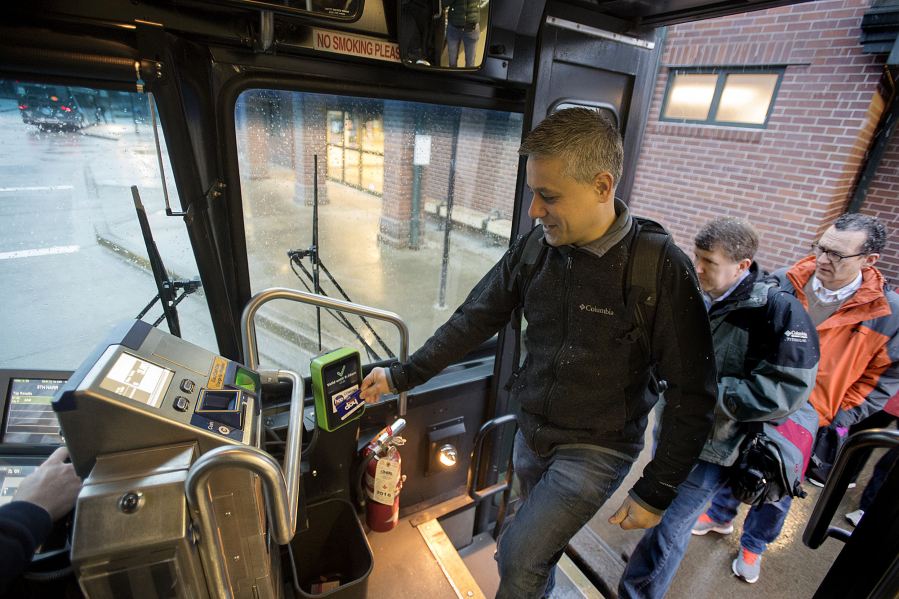Now that The Vine has taken root, C-Tran is focused on its next project: changing the way riders pay for a bus fare.
Later this year, rather than counting coins and paying in cash, public transit riders through the Vancouver-Portland metro area will be able to pay with a quick swipe of a smart card, bank card or smartphone via an electronic-fare payment system being implemented by C-Tran, Trimet and Portland Streetcar.
Last week, 250 regional riders started beta testing the efare system with a smart card called Hop Fastpass. Nate Silva was one of the 250 people chosen for the first round of beta testing. A computer programmer by training, Silva has regularly commuted from Vancouver to Portland for work for about the last two years.
“I’m always an early adopter with technology,” he said. “When I saw they were asking for testers, it was right up my alley.”
Silva said he likes that the card automatically reloads. He also likes that the system logs where and when he rides public transit and that the information is available to him as a downloadable spreadsheet.
“I’m the kind of person that’ll analyze that data to figure out what times and what days are shorter commutes,” he said.
The cards are going to a diverse pool of riders who are expected to give feedback and help identify the system’s bugs before it goes public in July. More testers will be added every two weeks. More than 5,000 people currently sit on the waiting list.
The beta testers will use an adult, youth or honored citizen Hop Fastpass card, which they will load and reload with their own money. They’ll tap the card every time they board a bus or train and relay their experiences to the agencies later on.
Regular C-Tran riders might have already noticed the more than 40 new payment kiosks on The Vine stations, all of which should be equipped by the end of March.
Initially, testers will be able to reload their cards at 100 locations. When the system is fully launched, the cards will be available at more than 500 retail locations, from supermarkets, pharmacies and convenience stores. Also, riders will be able to load their cards via a mobile app, website, phone, or at a bus ticket office.
When the efare system goes live to the public in July, passengers will also be able to scan a chip-enabled credit or debit card as payment, but the agencies say the Hop Fastpass card will give riders the best deal possible. Once users reach the cost of a day pass, the rest of that day’s rides are free. The system applies on a monthly basis; once a rider reaches the cost of a month, the rest of the month is free. Also, the same as with a monthly pass, if an adult rides twice daily for 20 days, the rest of the month’s rides are free.
Registered cards can be automatically loaded and have protections if they’re lost. There is no fee for using them, but there is a $3 fee for the card and any replacements.
During April and May, C-Tran and TriMet will test payment systems for Apple and Android smartphones.
Those uninterested in going electronic will still have the option of paying in cash. The agencies say electronic payments will make it more convenient and faster to board the bus and pay for fares. Meanwhile, drivers benefit from a more efficient fare collection system.
The region’s transit agencies began planning the system more than five years ago. Overall, regional implementation costs including hardware, software, staff time and consultant costs currently stand at $35.9 million.
“C-Tran’s cost is a small fraction of this,” Selk wrote in an email to The Columbian.
Paratransit won’t use efare until late this year or early 2018. The transit agencies have to first figure out how to make efare work with the ride reservation system.
C-Tran is paying its portion of the implementation cost based on the number of taps made by passengers. Since C-Tran’s ridership makes up about 6 percent of the region’s, the agency will pay only that much of the cost.
Prior to the public Fastpass launch, C-Tran plan connect with members of the public to educate them about the basics of the card.
For more information, visit myhopcard.com.




